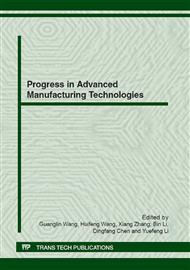p.210
p.217
p.221
p.227
p.231
p.236
p.240
p.245
p.251
Cutting Performance of Cemented Carbide Tool in High-Efficiency Turning Ti6Al4V
Abstract:
The machining efficiency of titanium alloy Ti6Al4V is low and the tool wear is serious. In this paper, uncoated carbide tool and two kinds of coated cemented carbide tool were used for dry turning titanium alloy. The experiments used CCD Observing System and the EDAX analysis of SEM to study tool wear mechanism and analyze the cutting performance through tool life, cutting force and cutting temperature. The results show that the main wear reasons are adhesion, diffusion and oxidation wear. For coated tool, the coating peeled off first, and then tool substrate damaged. Compared with coated carbide tool, the uncoated carbide tool with fine grain has longer tool life and lower cutting force and cutting temperature. The changes of cutting force and cutting temperature with cutting speed are not obvious when using the ccomposite coating (TiAlN and AlCrN) carbide tool. The results can help to choose tool material reasonably and control tool wear.
Info:
Periodical:
Pages:
231-235
Citation:
Online since:
August 2012
Authors:
Price:
Сopyright:
© 2012 Trans Tech Publications Ltd. All Rights Reserved
Share:
Citation:


